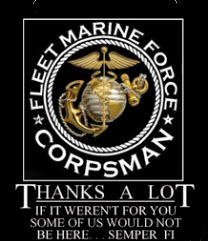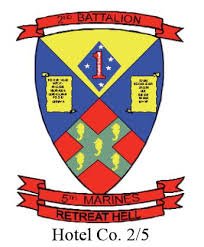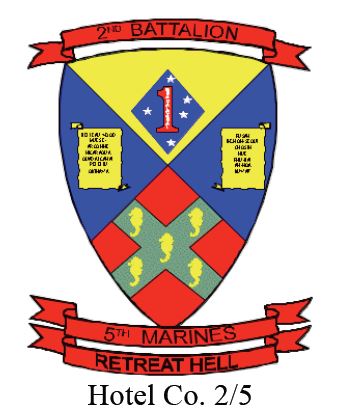Larry Tyler presented the Navy Corpsman Lapel Pin (Gold) and the Navy Corpsman Hat Patch to Doc Joe Sonderman and Dennis Noah at our Branson, MO 2023 reunion.


The citation reads as follows:
During the Vietnam War 10,000 Navy Hospital Corpsmen served with their Marine brothers. 645 of them were killed in action (KIA), and one-third were wounded in action (WIA). We didn’t know them as Hospital Corpsmen, we knew them as Combat Corpsmen. They were also known as FMF (Fleet Marine Force) Corpsmen.

In the Navy (as well as the Marine Corps), Navy Hospital Corpsmen (HM) are basically Emergency Medical Technicians (EMTs). Most are nicknamed “Doc” as an informal way to address the medically trained member in our unit. Though they have more education and training than the basic EMT, they also perform duties as assistants in the prevention and treatment of disease and injury and assist health care professionals in providing medical care to Navy people and their families. Many have higher functions as clinical or specialty technicians, medical administrative personnel, and health care providers at medical treatment facilities. HMs also serve as battlefield corpsmen with the Marine Corps and Special Operations Units, rendering emergency medical treatment to include initial treatment in a combat environment.
When in combat while bullets are flying and explosions going off all around us, we would yell “Corpsman up!” Or “250 Up” would be our yell!
This is how each of our Docs here today would respond:
Dennis Noah – nicknamed Doc Noah, with the fresh smell of blood and he’d come running before we finished yelling it out “Corpsman up!”
Joe Sonderman – nicknamed Doc 250, because of his weight (a big target),
he would come running in a moment’s notice, faster than a cat with its tale on fire, whenever he heard the call of “250 Up!”
These Corpsmen not only wore Navy strips, and strips on their underwear, they wore the Marine Corps combat uniform in Vietnam. They fought beside us and carried their medical kits, .45’s and picked up a rifle, a grenade or two, and carried C4 as needed from time to time. They fought beside us and ran to us when we began to bleed.
There is no other relationship or bond like that between Marines and their Navy Corpsmen. It is said of them that they would “go through the gates of hell for one of their wounded Marines.” But it was also true that their Marine brothers would fight like hell to protect their Corpsmen.
Beloved by their fellow 2/5 grunts,
corpsmen and medics
are the first responders for Marines
and
soldiers wounded on the battlefield.
Medics and corpsmen didn’t spend all their time running and crawling about under fire dodging bullets, although that’s all they talk about at reunions swapping their very, very exaggerated war stories. Usually, they spent six months in the field with us combat units and then 6 months in the rear like An Hoa, Da Nang, etc.
Mundane day-to-day matters consumed most of their time: like ensuring us men took our dreaded Dapsone anti-malaria pills, making sure we drank copious amounts of water and took enough salt pills each day, cleaning out boils that erupted, and raw flesh sores when our web gear etched red, salty wounds into our sweaty flesh. They spent time checking out our bodies looking for leaches and body rot. And, oh ya, they were checking our feet and toes constantly.
It was these daily tasks, as much perhaps as combat itself, that earned these guys the title of “Doc.” When they weren’t playing medic, or combat Marine, they would sit around telling us wild stories, joking, and laughing with us to help us forget about the mental and physical pain we were suffering.
In the field, our medics’ medical kits contained — among other items — bandages, abdominal dressings, flexible plastic coverings for treating sucking chest wounds, IVs, surgical knives, clamps, and morphine.
In the rear, these Docs spent their time drinking up our beer and sleeping it off, while us grunts sat in foxholes all night protecting their ****. Actually, they were busy taking care of the hospital patients (USMC and Civilians), seeing to it that all cuts, bruises, and sores were cared for, everyone was taking their medications and getting their shots.
There is a strange relationship between battlefield patients and their Corpsmen or medics. It is a paradox of intimate detachment. Doc Joe once told me, “When you are caring for a wounded Marine, your focus is intimately on that man and his wounds. When you hear that call, “Corpsman Up!” over the din of battle, you start moving toward that cry and your mind starts to focus on the mantra you learned in Field Medical Service School, “Clear the airway, stop the bleeding, prevent or treat for shock, keep them breathing!””
Doc Noah told me this once, “Some I knew, most I didn’t, I’d talk with them and tell them they were going to live, I’d patch them up, help carry them to the chopper, and medevac’d them. I never would say goodbye. I never knew if they lived or died. I just did the best I could to get them keep them alive and safe until they were under someone else’s care.”
We present to you this day, the Navy Corpsman Lapel Pin as a small token of our appreciation and love for your service to us and your country.
The lapel pin is designed to be worn to indicate wearer’s affiliation as a Hospital Corpsman in the U.S. Navy.
We also would like to present to you the Navy Corpsman Navy Hat Patch to be sewn on your hat as a constant reminder that if it weren’t for you, some of us would not be here today. Thank you for your sacrifice!
Thanks again Docs for all you did for us back then. Let’s thank them and honor them while at our reunion this year.
Oh, by the way: Please Note: If anyone forgot to bring their first aid kit, their malaria pills, or their salt pills, or some Tylenol for that matter, please see one of these docs during your reunion stay.

